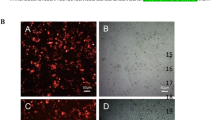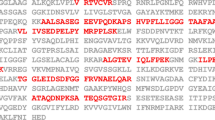Abstract
The targeted inhibition of antiapoptotic factors in tumour cells may provide a rational approach towards the development of novel anticancer therapies. Using human papillomavirus (HPV)-transformed cells as a model system, we investigated if RNA interference (RNAi)-mediated gene silencing can be employed in order to overcome the apoptosis resistance of cancer cells. We found that both vector-borne and synthetic small interfering (si)RNAs, specifically directed against the antiapoptotic HPV E6 oncogene, restored dormant tumour suppressor pathways in HPV-positive cancer cells that are otherwise inactive in the presence of E6. This ultimately resulted in massive apoptotic cell death, selectively in HPV-positive tumour cells. These findings show that RNAi provides a powerful molecular strategy to inactivate intracellular E6 function efficiently. Moreover, they define E6 as a most promising therapeutic target to eliminate HPV-positive tumour cells specifically by RNAi. Thus, by sequence-specific targeting of antiapoptotic genes, siRNAs may be developed into novel therapeutics that can efficiently correct the apoptosis deficiency of cancer cells.
This is a preview of subscription content, access via your institution
Access options
Subscribe to this journal
Receive 50 print issues and online access
$259.00 per year
only $5.18 per issue
Buy this article
- Purchase on Springer Link
- Instant access to full article PDF
Prices may be subject to local taxes which are calculated during checkout





Similar content being viewed by others
References
Agami R . (2002). Curr. Opin. Chem. Biol., 6, 829–834.
Brummelkamp TR, Bernards R and Agami R . (2002a). Cancer Cell, 2, 243–247.
Brummelkamp TR, Bernards R and Agami R . (2002b). Science, 296, 550–553.
Butz K, Denk C, Ullmann A, Scheffner M and Hoppe-Seyler F . (2000). Proc. Natl. Acad. Sci. USA, 97, 6693–6697.
Butz K, Geisen C, Ullmann A, Zentgraf H and Hoppe-Seyler F . (1998). Oncogene, 17, 781–787.
Butz K, Shahabeddin L, Geisen C, Spitkovsky D, Ullmann A and Hoppe-Seyler F . (1995). Oncogene, 10, 927–936.
Chen C and Okayama H . (1987). Mol. Cell. Biol., 7, 2745–2752.
Chomczynski P and Sacchi N . (1987). Anal. Biochem., 162, 156–159.
Cole ST and Danos O . (1987). J. Mol. Biol., 193, 599–608.
Elbashir SM, Harboth J, Lendeckel W, Yalcin A, Weber K and Tuschl T . (2001). Nature, 411, 494–498.
Elbashir SM, Harboth J, Weber K and Tuschl T . (2002). Methods, 26, 199–213.
El-Deiry WS, Tokino T, Velculescu VE, Parsons R, Trent JM, Lin D, Mercer WE, Kinzler KW and Vogelstein B . (1993). Cell, 75, 817–825.
Evan GI and Vousden KH . (2001). Nature, 411, 342–348.
Fire A, Xu S, Montgomery MK, Kostas SA, Driver SE and Mello CC . (1998). Nature, 391, 806–811.
Fulda S, Wick W, Weller M and Debatin M . (2002). Nat. Med., 8, 808–815.
Funk WD, Pak DT, Karas RH, Wright WE and Shay JW . (1992). Mol. Cell. Biol., 12, 2866–2871.
Goodwin EC and DiMaio D . (2000). Proc. Natl. Acad. Sci. USA, 97, 12513–12518.
Hoppe-Seyler F and Butz K . (1999). Anticancer Res., 19, 4747–4758.
Igney FH and Krammer PH . (2002). Nat. Rev. Cancer, 2, 277–288.
Jaque J-M, Triques K and Stevenson M . (2002). Nature, 418, 435–438.
Jiang M and Milner J . (2002). Oncogene, 21, 6041–6048.
Lee NS, Dohjima T, Bauer G, Li H, Li M-J, Ehsani A, Salvaterra P and Rossi J . (2002). Nat. Biotechnol., 19, 500–505.
Mantovani F and Banks L . (2001). Oncogene, 20, 7874–7887.
Mittnacht S . (1998). Curr. Opin. Genet. Dev., 8, 21–27.
Morris MC, Chaloin L, Heitz F and Divita G . (2000). Curr. Opin. Biotechnol., 11, 461–466.
Münger K, Basile JR, Duensing S, Eichten A, Gonzalez SL, Grace M and Zacny VL . (2001). Oncogene, 20, 7888–7898.
Nicholson DW . (2000). Nature, 407, 810–816.
Novina CD, Murray MF, Dykxhoorn DM, Beresford PJ, Riess J, Lee S-K, Collman RG, Lieberman J, Shankar P and Sharp PA . (2002). Nat. Med., 8, 681–686.
Paddison PJ and Hannon GJ . (2002). Cancer Cell, 2, 17–23.
Pan H and Griep AE . (1994). Genes Dev., 9, 2157–2169.
Parkin DM, Bray FI and Devesa SS . (2001). Eur. J. Cancer, 37, S4–S66.
Reed JC . (2001). Trends Mol. Med., 7, 314–319.
Rittner K, Benavente A, Bompard-Sorlet A, Heitz F, Divita G, Brasseur R and Jacobs E . (2002). Mol. Ther., 5, 104–114.
Rothbard JB, Garlington S, Lin Q, Kirschberg T, Kreider E, McGrane PL, Wender P and Khavari PA . (2000). Nat. Med., 11, 1253–1257.
Salvesen GS and Duckett CS . (2002). Nat. Rev. Mol. Cell. Biol., 3, 401–410.
Scheffner M, Werness BA, Huibregtse JM, Levine AJ and Howley PM . (1990). Cell, 63, 1129–1136.
Schneider-Gaedicke A and Schwarz E . (1986). EMBO J., 5, 2285–2292.
Sedman SA, Barbosa MS, Vass WC, Hubbert NL, Haas JA, Lowy DR and Schiller JT . (1991). J. Virol., 65, 4860–4866.
Smotkin D, Prokoph H and Wettstein FO . (1989). J. Virol., 63, 1441–1447.
Southern PJ and Berg P . (1982). J. Mol. Appl. Genet., 1, 327–341.
Thomas M and Banks L . (1998). Oncogene, 17, 2943–2954.
Thomas M and Banks L . (1999). Oncogene, 18, 7690–7700.
Venturini F, Braspenning J, Homann M, Gissmann L and Sczakiel G . (1999). Nucleic Acids Res., 27, 1585–1592.
von Knebel Doeberitz M, Oltersdorf T, Schwarz E and Gissmann L . (1988). Cancer Res., 48, 3780–3786.
Wells SI, Francis DA, Karpova AY, Dowhanick JJ, Benson JD and Howley PM . (2000). EMBO J., 19, 5762–5771.
Zur Hausen H . (2002). Nat. Rev. Cancer, 2, 342–350.
Acknowledgements
This article is dedicated to Harald zur Hausen on the occasion of his retirement as head of the German Cancer Research Center with gratitude and appreciation for 20 years of leadership. We thank A Ullmann for excellent technical assistance. We are grateful to R Agami for plasmids pSUPER and pSUPER-p53, and to H Zentgraf for antibody 18E7C. TR was a recipient of a stipend of the Fondation pour la Recherche Médicale and currently has a stipend of the Alexander von Humboldt-Stiftung. This work was supported by the Deutsche Krebshilfe (I0-I930-Ho 5; HS) and the Zentrum für Molekulare Medizin Köln (MS).
Author information
Authors and Affiliations
Corresponding author
Rights and permissions
About this article
Cite this article
Butz, K., Ristriani, T., Hengstermann, A. et al. siRNA targeting of the viral E6 oncogene efficiently kills human papillomavirus-positive cancer cells. Oncogene 22, 5938–5945 (2003). https://doi.org/10.1038/sj.onc.1206894
Received:
Revised:
Accepted:
Published:
Issue Date:
DOI: https://doi.org/10.1038/sj.onc.1206894
Keywords
This article is cited by
-
HPV E6/E7: insights into their regulatory role and mechanism in signaling pathways in HPV-associated tumor
Cancer Gene Therapy (2024)
-
Role of extracellular vesicle in human papillomavirus-associated cervical cancer
Journal of Cancer Research and Clinical Oncology (2023)
-
Hyperactivating p53 in Human Papillomavirus-Driven Cancers: A Potential Therapeutic Intervention
Molecular Diagnosis & Therapy (2022)
-
Drug repurposing approach for the identification and designing of potential E6 inhibitors against cervical cancer: an in silico investigation
Structural Chemistry (2020)
-
Benzothiazole derivative bearing amide moiety induces p53-mediated apoptosis in HPV16 positive cervical cancer cells
Investigational New Drugs (2020)



